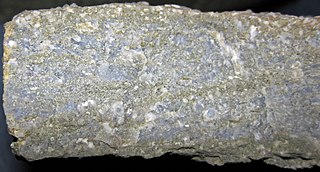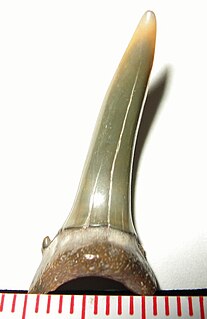| Coffee Mill Hammock Formation | |
|---|---|
| Type | Formation |
| Location | |
| Region | Florida |
| Country | United States |
The Coffee Mill Hammock Formation is a geologic formation in Florida. The formation is about two-feet thick and is composed of shell marl. It sits on top of the Fort Thompson Formation and preserves fossils from the Late Pleistocene, [1] predominantly Chione cancellata. It can be seen at Goodno's Landing, Fort Thompson, and at Coffee Mill Hammock, 12 north of LaBelle, Florida, in Glades County. [2]

Devil's Millhopper Geological State Park is a Florida State Park located in the north-westernmost part of Gainesville, Florida, off County Road 232, also known as NW 53rd Avenue and Millhopper Road, northwest of the University of Florida.

The Fort Payne Formation, or Fort Payne Chert, is a geologic formation found in the southeastern region of the United States. It is a Mississippian Period cherty limestone, that overlies the Chattanooga Shale, and underlies the St. Louis Limestone. To the north, it grades into the siltstone Borden Formation. It preserves fossils dating back to the Carboniferous period.

The Eday Group is a Devonian lithostratigraphic group in Orkney, northern Scotland. The name is derived from the island of Eday where the strata are exposed in coastal cliffs.
The Rose Hill Formation is a geologic formation in West Virginia, United States. It preserves fossils dating back to the Silurian period, and is a source of iron ore for nearby foundries.
The Duplin Marl is a geologic formation in North Carolina. It preserves fossils dating back to the Neogene period.
The Belgrade Formation is a limestone geologic formation in North Carolina characterized by limestone coquina mixed with sand, and thinly laminated clays. It preserves fossils dating back to the Paleogene period.
The River Bend Formation is a limestone geologic formation in North Carolina. It preserves fossils dating back to the Paleogene period.
The Java Formation is a geologic formation in Kentucky, New York, Ohio, Pennsylvania, Tennessee, Virginia, West Virginia. It preserves fossils dating back to the Devonian period. The formation comprises the Pipe Creek Shale, Wiscoy Sandstone Member in New York, and Hanover Shale Member except in Tennessee.
The Warley Hill Marl is a geologic formation in South Carolina. It preserves fossils dating back to the Paleogene period.
The Raysor Marl is a geologic formation in South Carolina. It preserves fossils dating back to the Neogene period.
The Alum Bluff Group is a geologic group in the states of Georgia, Florida, and Alabama. It preserves fossils dating back to the Neogene period.

The Bermont Formation is a geologic formation in Florida. It preserves mostly invertebrate fossils that date back to the Middle Pleistocene. Most of the fossils preserved are extant mollusk shells. It is mined commercially along with similar formations, to produce shell fill for construction.

The Fort Thompson Formation is a geologic formation in Florida. It preserves fossils dating back to the late Pleistocene. It was influenced by sea level changes.

The Bone Valley Formation is a geologic formation in Florida. It is sometimes classified as the upper member of the Peace River Formation of the Hawthorn Group. It contains economically important phosphorite deposits that are mined in west-central Florida, as well as rich assemblages of vertebrate fossils.
The Pachuta Marl is a geologic formation in Alabama. It preserves fossils dating back to the Paleogene period.
The Franconia Formation is a geologic formation in the upper mid-western United States, with outcroppings found in Illinois, Indiana, Iowa, Michigan, Minnesota, Missouri, Ohio, and Wisconsin. It preserves fossils dating back to the Cambrian period. It was named the Franconia Formation due to the first published documentation of exposures in vicinity of Franconia, Minnesota in the 1897 Ph.D. dissertation by Charles P. Berkley at the University of Minnesota titled Geology of the St. Croix Dalles. The Franconian stratigraphic stage was named after this formation.
The Brownstown Marl is a geologic formation in Arkansas. It preserves fossils dating back to the Cretaceous period.
The White Bluff Formation is a marl, sand, and clay geologic formation in Arkansas that is part of the Jackson Group. It preserves fossils dating back to the Paleogene period, specifically the Eocene.
The La Jolla Group is a group of geologic formations in coastal southwestern San Diego County, Southern California. Its locations include the coastal La Jolla San Diego region.
The Marl Slate Formation is a geological formation in England. Despite its name, it is mostly dolomite rock. The Marl Slate Formation was formed about 273 to 259 million years ago, during the Guadalupian and Lopingian epochs of the late Permian period of the Earth's geological history. This formation is part of the Zechstein Group of rocks, and is equivalent to the Kupferschiefer of Germany. The Marl Slate Formation contains fossils including the conodont Mesogondolella britannica and the dorypterid fishes Dorypterus and Lekanichthys, as well as the gliding reptile Weigeltisaurus and terrestrial reptile Protorosaurus The Marl Slate Formation outcrops in County Durham and Yorkshire in north-east England.